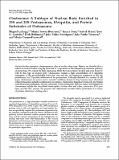Por favor, use este identificador para citar o enlazar a este item:
http://hdl.handle.net/10261/24494COMPARTIR / EXPORTAR:
 SHARE SHARE
 CORE
BASE CORE
BASE
|
|
| Visualizar otros formatos: MARC | Dublin Core | RDF | ORE | MODS | METS | DIDL | DATACITE | |

| Campo DC | Valor | Lengua/Idioma |
|---|---|---|
| dc.contributor.author | Lafarga, Miguel | - |
| dc.contributor.author | Berciano, María T. | - |
| dc.contributor.author | Pena, Emma | - |
| dc.contributor.author | Mayo, Isabel | - |
| dc.contributor.author | Castaño, José G. | - |
| dc.contributor.author | Bohmann, Dirk | - |
| dc.contributor.author | Rodrigues, João Pedro | - |
| dc.contributor.author | Tavanez, João Paulo | - |
| dc.contributor.author | Carmo-Fonseca, Maria | - |
| dc.date.accessioned | 2010-05-19T12:03:55Z | - |
| dc.date.available | 2010-05-19T12:03:55Z | - |
| dc.date.issued | 2002-08 | - |
| dc.identifier.citation | Molecular Biology of the Cell 13(8): 2771-2782 (2002) | en_US |
| dc.identifier.issn | 1059-1524 | - |
| dc.identifier.uri | http://hdl.handle.net/10261/24494 | - |
| dc.description | 12 páginas, 9 figuras. | en_US |
| dc.description.abstract | Nuclear bodies represent a heterogeneous class of nuclear structures. Herein, we describe that a subset of nuclear bodies is highly enriched in components of the ubiquitin-proteasome pathway of proteolysis. We coined the term clastosome (from the Greek klastos, broken and soma, body) to refer to this type of nuclear body. Clastosomes contain a high concentration of 1) ubiquitin conjugates, 2) the proteolytically active 20S core and the 19S regulatory complexes of the 26S proteasome, and 3) protein substrates of the proteasome. Although detected in a variety of cell types, clastosomes are scarce under normal conditions; however, they become more abundant when proteasomal activity is stimulated. In contrast, clastosomes disappear when cells are treated with proteasome inhibitors. Protein substrates of the proteasome that are found concentrated in clastosomes include the short-lived transcription factors c-Fos and c-Jun, adenovirus E1A proteins, and the PML protein. We propose that clastosomes are sites where proteolysis of a variety of protein substrates is taking place. | en_US |
| dc.description.sponsorship | This study was supported by grants from Fondo de Investigaciones Sanitarias (FIS 00/0947) and Fundacion Marqués de Valdecilla (00/2), Spain, and Fundaçâo para a Ciência e Tecnologia, Portugal. | en_US |
| dc.format.extent | 1887125 bytes | - |
| dc.format.mimetype | application/pdf | - |
| dc.language.iso | eng | en_US |
| dc.publisher | American Society for Cell Biology | en_US |
| dc.rights | openAccess | en_US |
| dc.title | Clastosome: a subtype of nuclear body enriched in 19S and 20S proteasomes, ubiquitin, and protein substrates of proteasome | en_US |
| dc.type | artículo | en_US |
| dc.identifier.doi | 10.1091/mbc.E02-03-0122 | - |
| dc.description.peerreviewed | Peer reviewed | en_US |
| dc.relation.publisherversion | http://dx.doi.org/10.1091/mbc.E02-03-0122 | en_US |
| dc.identifier.pmid | 12181345 | - |
| dc.type.coar | http://purl.org/coar/resource_type/c_6501 | es_ES |
| item.openairetype | artículo | - |
| item.grantfulltext | open | - |
| item.cerifentitytype | Publications | - |
| item.openairecristype | http://purl.org/coar/resource_type/c_18cf | - |
| item.fulltext | With Fulltext | - |
| item.languageiso639-1 | en | - |
| Aparece en las colecciones: | (IBBTEC) Artículos (IIBM) Artículos | |
Ficheros en este ítem:
| Fichero | Descripción | Tamaño | Formato | |
|---|---|---|---|---|
| 2771.pdf | 1,84 MB | Adobe PDF |  Visualizar/Abrir |
CORE Recommender
PubMed Central
Citations
55
checked on 26-mar-2024
SCOPUSTM
Citations
112
checked on 15-abr-2024
WEB OF SCIENCETM
Citations
109
checked on 25-feb-2024
Page view(s)
338
checked on 19-abr-2024
Download(s)
485
checked on 19-abr-2024
Google ScholarTM
Check
Altmetric
Altmetric
Artículos relacionados:
NOTA: Los ítems de Digital.CSIC están protegidos por copyright, con todos los derechos reservados, a menos que se indique lo contrario.
